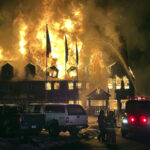Losses to the insurance industry from Hurricane Michael, a Category 4 storm that hit the Florida Panhandle before continuing a path of destruction through several other Southeast states, will be substantial but not enough to cause problems for insurers or a pullback in capacity, experts say.
Ohio-based ratings firm Demotech, which rates 52 Florida-based insurers as well as others in surrounding states affected by Michael, said these companies are well positioned to handle losses. “Demotech believes that each of the carriers that we review and rate that are exposed to loss and LAE from Hurricane Michael have in place a rigorous and vigorous catastrophe reinsurance program,” Demotech President Joseph L. Petrelli told Insurance Journal.
Others agree that Florida’s heavily-reinsured domestic insurers and an overall well-capitalized insurance industry should be able to handle Michael’s losses without major disruption.
A report by A.M. Best said depending on the severity of losses, primary insurers will likely share the loss burden with traditional reinsurers and alternative capital providers. Reinsurers with an outsize concentration in Florida will be more vulnerable than those with globally diversified catastrophe exposures, Moody’s said.
“Insurers most exposed to the storm will be Florida-only insurers, which we define as insurance companies with at least 75 percent of their homeowners and commercial property premiums written in Florida,” said Bruce Ballentine, a Moody’s analyst.
Howard Mills, Global Insurance Regulatory leader of Deloitte, said that while Michael was the most powerful storm to ever hit the Florida Panhandle, “it’s not going to be a market moving storm.” He said the insurance industry and the global reinsurance industry are “very well capitalized … there are hundreds of billions of dollars in capital and surplus and they are well positioned to handle this storm.”
Mills noted Florida is a “unique” market with it mostly dominated by smaller, regional carriers that carry a lot of the risk in Florida, but they are “heavily backed by reinsurance.”
“The good news from an economic perspective is that these claims will be paid by the global reinsurance market – the London market and reinsurers based in Bermuda, Europe and Japan,” Mills said.
The presence of smaller Florida-based insurers has grown since many national carriers exited the market after the active 2004/2005 hurricane season. As of 2016, Florida domestic insurers wrote most of the coverage in the Florida property insurance market, according to the Florida Office of Insurance Regulation.
Demotech’s Petrelli noted that Florida -focused property insurers rated by Demotech are reviewed six times per year and are heavily reinsured by global reinsurers, as well as the Florida Hurricane Catastrophe Fund.
“Catastrophe bonds and other insurance linked securities supplement their catastrophe programs,” Petrelli noted.
Each of the companies rated by Demotech will provide periodic reports on their claims activity to the ratings firm, Petrelli said.
A.M. Best does not anticipate a larger number of ratings actions related to Hurricane Michael as catastrophic events like it are considered in insurance companies’ current ratings and outlooks. Insurers with the largest market shares in U.S. states to be hit by Hurricane Michael have considerable exposures, but these are manageable given each company’s overall policyholder surplus, Best said.
Furthermore, while nearly all A.M. Best-rated Florida property companies have substantial property catastrophe premium, some have strategically limited their exposures in the Panhandle, and therefore are not significantly exposed to this hurricane.
“However, the question of how the state’s relatively new, Florida-specific insurers might withstand the impact of substantial insurable losses caused by Hurricane Michael remains,” Best noted.
The potential for insurable losses could put some pressure on reinsurers, Best said, but the actual impact of the hurricane will depend on a number of yet undetermined factors, though “A.M. Best believes that most of the affected rated carriers have sufficient capital and appropriate reinsurance programs to withstand this event effectively.”
Best added that the vertical and horizontal reinsurance purchases for the 2018 season represent the highest dollar limit in the history of the state of Florida.
Fitch Ratings said Hurricane Michael will push 2018 closer to a more normal catastrophe loss year, following a relatively benign first half of 2018.
Fitch also noted that Michael’s private insurers will bear a greater burden from Michael than Florence because of wind-related losses from Michael compared to Florence’s significant flooding losses. But, Fitch agrees that “insurers should be well positioned to absorb losses of this magnitude,” referring to a recent estimate from Karen Clark & Co. saying private insured losses from Michael could approach $8 billion.
Catastrophe risk modeling firm AIR Worldwide estimates that industry insured losses resulting from Hurricane Michael’s winds and storm surge will range from $6 billion to $10 billion. CoreLogic estimated losses could reach $4.5 billion.
Hurricane Michael’s Destruction in Photos
Fitch said Florida’s domestic insurers will have considerable gross losses but that they will not exceed their reinsurance coverage limits.
Deloitte’s Mills said Hurricane Michael will not be enough to lead to a pricing shift for reinsurance.
“There may be some small impact on quarterly returns, but the global reinsurance industry is so well capitalized I do not expect this storm to impact rate and price,” he said.
Fitch’s assessment echoed Mills, saying it does not expect the storm to serve as a catalyst for reinsurance rate increases given how muted pricing increases were following the much larger 2017 second half catastrophe loss events.
Meyer Shields, an analyst with financial services firm Keefe, Bruyette & Woods, (KBW’) said that even if CoreLogic’s $2.0-$4.5 billion insured Hurricane Michael loss estimate proves somewhat low, he is confident that most primary insurers can readily absorb their net losses. As for reinsurers, Shields “strongly doubts” that year-to-date industry-wide catastrophe losses will disrupt “orderly and modestly soft January reinsurance renewals.
Related:
- Hurricane Michael’s Destruction in Photos
- Michael Leaves Path Of Destruction Through Florida Panhandle
- Fast, Furious: How Michael Became a 155mph Monster Hurricane
- A.M. Best: Insurer Losses from Hurricane Michael Will Be ‘Significant’
- CoreLogic Estimates Hurricane Michael Losses Could Top $4.5B; Top 10 Insurers Affected
- Insurers, Reinsurers Can Handle Hurricane Michael Losses: Fitch
- AIR: Hurricane Michael Strongest Storm to Hit Florida Panhandle on Record
Topics Catastrophe Natural Disasters Carriers Florida Profit Loss Reinsurance Property Hurricane AM Best Market
Was this article valuable?
Here are more articles you may enjoy.


 Acrisure CEO Greg Williams Makes $400M Commitment to Michigan State University
Acrisure CEO Greg Williams Makes $400M Commitment to Michigan State University  Chubb, The Hartford, Liberty and Travelers Team Up on Surety Tech Launch
Chubb, The Hartford, Liberty and Travelers Team Up on Surety Tech Launch  Baldwin Group to Buy CAC Group for About $1B in Cash and Stock
Baldwin Group to Buy CAC Group for About $1B in Cash and Stock  Owner of Historic Minnesota Resort Charged With Arson, Insurance Fraud
Owner of Historic Minnesota Resort Charged With Arson, Insurance Fraud 

